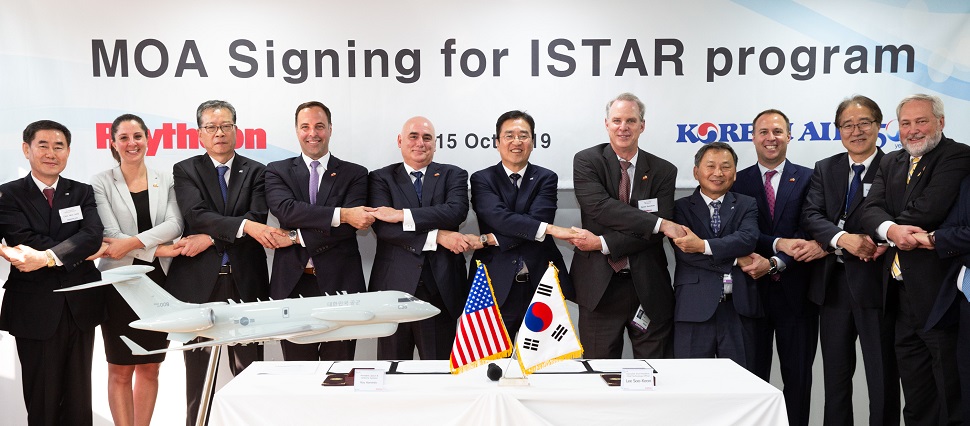The 2020s will see the Republic of Korea Air Force (ROKAF) obtain new aircraft for three emergent requirements.
The requirements include a new Intelligence Surveillance Target Acquisition and Reconnaissance (ISTAR) programme, two additional airborne early warning & control (AEW&C) aircraft, and possibly a dedicated electronic warfare (EW) platform.
Industry sources at this year’s ADEX show indicate that a competition is imminent for four ISTAR aircraft. Key capabilities will include synthetic aperture radar and GMTI (ground moving target indication).
Raytheon and Korean Airlines will partner for the requirement with the US company as prime contractor. The pair will use a Bombardier Global 6500 business jet for their offer. Raytheon will provide “multiple intelligence” (Multi-INT) technologies. Korean Air will perform aircraft modification work should their eventual bid be successful.

Raytheon, Korean Air firm teaming agreement for ISTAR campaign
Korean Air
Prior to the ADEX show, Raytheon brought a Global 6000 equipped for the Multi-INT function to Seoul, showing it to officials and air force personnel.
IAI and Boeing could also potentially be interested in the project.
“We will evaluate Korea’s ISTAR requirements closely when they are released,” says Boeing.
“In general, we can share that Boeing’s ability to offer world-class ISTAR capability on a 737-derivative platform is well understood, offering unmatched advantages over business jets when it comes to size, weight, power, and cooling.”
Seoul also has an emerging requirement for two AEW&C assets to add to its four Peace Eye 737s. Contenders could include Boeing with two more 737-based aircraft, Saab with the GlobalEye, and IAI with its CAEW (Conformal Airborne Early Warning & Control System) offering.
Saab’s GlobalEye is based on the Global 6000, while IAI’s CAEW offering is based on the Gulfstream 550.
Saab contends that GlobalEye would be a great complement for Seoul’s existing AEW&C fleet, pointing out that the GlobalEye’s gallium-nitride based radar operates in the S-Band, as compared with the L-Band for the Peace Eye 737.
“With the introduction of GlobalEye we are turning the lights on in all domains,” says Saab executive Cazim Redzovic.
“We have extended range in air surveillance with traditional threats and targets, we have faster reaction and detection range for next-generation targets, we see smaller and further targets in the sea domain, and we are also introducing the land domain capability.”
A final - and far less defined - requirement for the mid-2020s appears to be a dedicated EW aircraft. Unsourced media reports have suggested that this could be for a type such as the EA-18G Growler. Sources at the show, however, indicate that such an acquisition is far from confirmed.






















